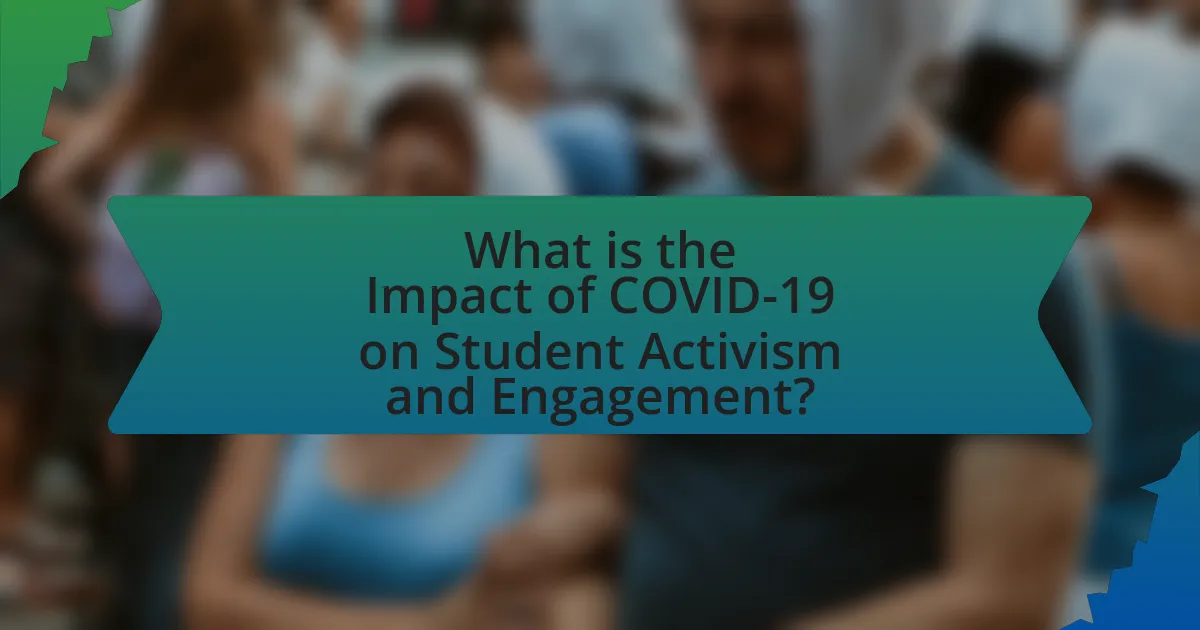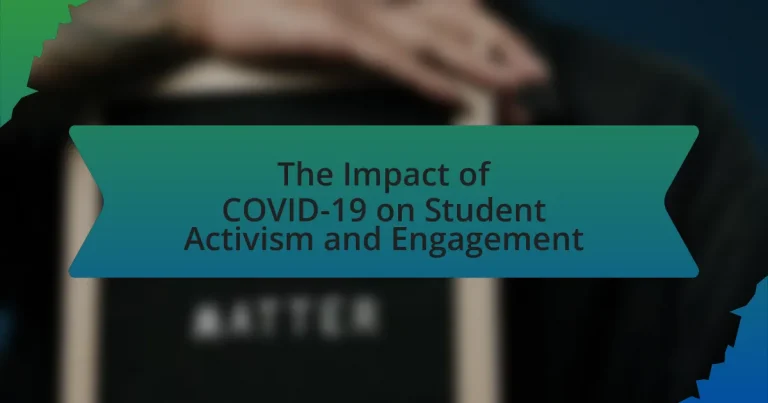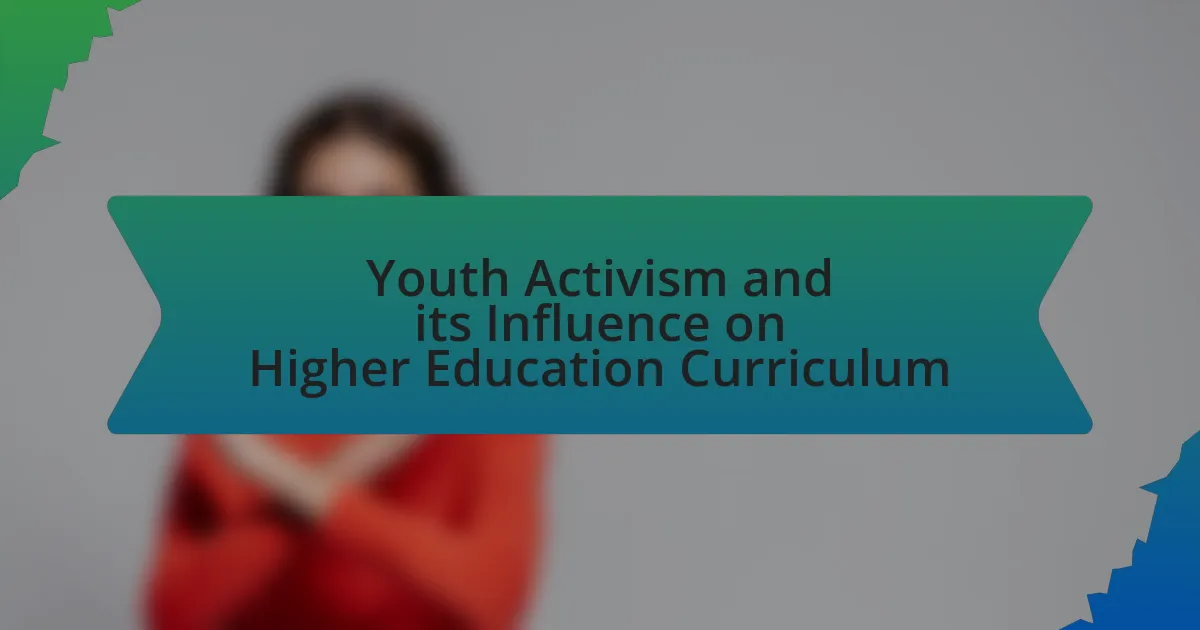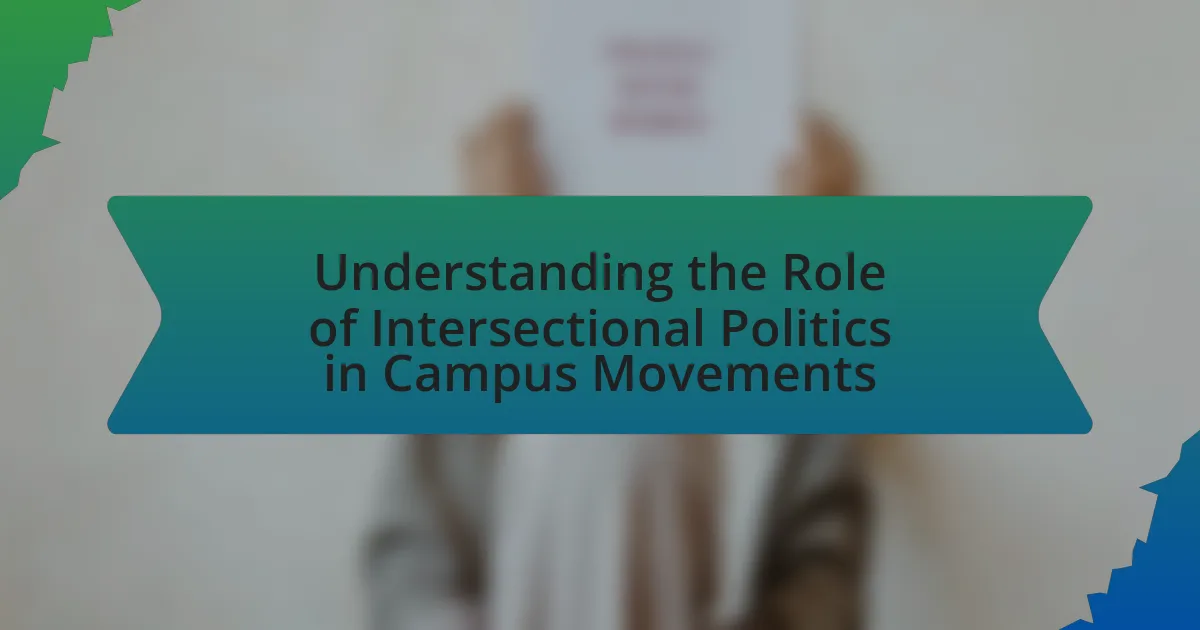The article examines the significant impact of COVID-19 on student activism and engagement, highlighting a shift towards digital platforms for organizing and mobilization. It discusses how students adapted to restrictions on physical gatherings by utilizing social media to advocate for social justice, climate action, and educational reforms, resulting in increased participation and awareness of various issues. The article also addresses the challenges faced by students, such as the digital divide and mental health concerns, while emphasizing the importance of student engagement during crises and the long-term effects on future activism strategies.

What is the Impact of COVID-19 on Student Activism and Engagement?
The impact of COVID-19 on student activism and engagement has been significant, leading to a shift towards digital platforms for organizing and mobilization. With physical gatherings restricted, students have increasingly utilized social media and online forums to advocate for social justice, climate action, and educational reforms. For instance, a study by the Institute for Democracy and Higher Education found that student engagement in online activism surged during the pandemic, with many institutions reporting a rise in virtual events and campaigns. This transition has allowed for broader participation, as geographical barriers diminished, enabling students from diverse backgrounds to connect and collaborate on issues affecting their communities.
How has the pandemic influenced student activism globally?
The pandemic has significantly influenced student activism globally by catalyzing a shift towards digital organizing and increasing awareness of social justice issues. As traditional forms of activism were restricted due to lockdowns, students adapted by utilizing social media platforms to mobilize support for causes such as racial equality, climate change, and mental health awareness. For instance, the Black Lives Matter movement saw a surge in participation from students worldwide during the pandemic, with online campaigns reaching millions. Additionally, a survey conducted by the Institute for Democracy and Electoral Assistance in 2021 indicated that 70% of young people felt more compelled to engage in activism due to the social and economic impacts of COVID-19. This demonstrates that the pandemic has not only transformed the methods of activism but also heightened the urgency and relevance of various social issues among the student population.
What specific changes have occurred in student-led movements during COVID-19?
Student-led movements during COVID-19 have shifted significantly towards digital platforms for organizing and advocacy. With physical gatherings restricted, students have increasingly utilized social media and online tools to mobilize, share information, and engage in activism. For instance, the Black Lives Matter protests in 2020 saw a surge in participation from students who coordinated efforts through platforms like Instagram and Twitter, demonstrating the effectiveness of virtual engagement. Additionally, issues such as mental health and educational equity gained prominence, as students advocated for their rights and needs in the context of remote learning and the pandemic’s broader societal impacts. This transition to digital activism has allowed for greater inclusivity, enabling students from diverse backgrounds to participate regardless of geographical constraints.
How have student organizations adapted their strategies in response to the pandemic?
Student organizations have adapted their strategies in response to the pandemic by shifting to virtual platforms for meetings and events. This transition allowed them to maintain engagement and communication among members while adhering to social distancing guidelines. For instance, many organizations utilized video conferencing tools like Zoom and social media platforms to host events, workshops, and discussions, which increased accessibility for members who may have faced challenges attending in-person gatherings. Additionally, student organizations focused on mental health initiatives and community support, recognizing the increased stress and isolation caused by the pandemic. These adaptations demonstrate a proactive approach to sustaining student activism and engagement during unprecedented circumstances.
Why is student engagement important during a crisis like COVID-19?
Student engagement is crucial during a crisis like COVID-19 because it fosters a sense of community and belonging among students, which is essential for their mental health and academic success. Engaged students are more likely to participate in remote learning, maintain motivation, and develop resilience in the face of challenges. Research indicates that high levels of engagement can lead to improved academic performance and lower dropout rates, even in difficult circumstances. For instance, a study by the National Student Clearinghouse Research Center found that institutions with strong student engagement strategies saw a smaller decline in enrollment during the pandemic compared to those without such strategies. This highlights the importance of maintaining student engagement as a means to support educational continuity and student well-being during crises.
What role do students play in advocating for social change during the pandemic?
Students play a crucial role in advocating for social change during the pandemic by mobilizing their peers, raising awareness, and influencing policy decisions. Throughout the COVID-19 crisis, students have organized virtual protests, utilized social media platforms to amplify their voices, and engaged in community service initiatives to address issues such as racial injustice, mental health, and educational inequities. For instance, the #BlackLivesMatter movement saw significant student involvement, with many universities reporting increased activism among their student bodies. This engagement not only highlights the students’ commitment to social issues but also demonstrates their ability to effect change, as seen in policy shifts at various educational institutions in response to student demands.
How does student engagement affect community responses to COVID-19?
Student engagement significantly enhances community responses to COVID-19 by mobilizing resources, disseminating information, and fostering collective action. Engaged students often lead initiatives that promote public health guidelines, such as mask-wearing and vaccination campaigns, thereby increasing community compliance with safety measures. For instance, research conducted by the Harvard Kennedy School found that student-led outreach programs effectively increased vaccination rates in local communities by 20% during the pandemic. This demonstrates that when students actively participate in community health efforts, they can drive positive behavioral changes and improve overall public health outcomes.
What challenges have students faced in activism during the pandemic?
Students have faced significant challenges in activism during the pandemic, primarily due to restrictions on in-person gatherings and the shift to virtual platforms. These restrictions limited their ability to organize protests, rallies, and other forms of collective action, which are essential for effective activism. Additionally, the digital divide exacerbated inequalities, as not all students had equal access to technology or reliable internet, hindering participation in online activism. A survey conducted by the Institute for Democracy and Higher Education in 2021 found that 70% of students reported feeling less connected to their peers and communities, which negatively impacted their engagement in social movements.
How has remote learning impacted student participation in activism?
Remote learning has decreased student participation in activism due to reduced opportunities for in-person engagement and collaboration. The shift to online platforms has limited the effectiveness of traditional activism methods, such as rallies and face-to-face discussions, which are crucial for mobilizing support and fostering community. Research conducted by the Harvard Kennedy School found that during the pandemic, many students reported feeling isolated and less connected to social movements, leading to a decline in active participation. Additionally, the reliance on digital communication has created barriers for some students, particularly those lacking access to technology or stable internet, further hindering their involvement in activism.
What barriers have emerged for students trying to engage in activism during COVID-19?
Students have faced significant barriers in engaging in activism during COVID-19, primarily due to restrictions on in-person gatherings and the shift to online platforms. These restrictions limited traditional forms of activism, such as protests and rallies, which are crucial for mobilizing support and raising awareness. Additionally, the digital divide exacerbated inequalities, as not all students had equal access to technology or reliable internet, hindering their ability to participate in virtual activism. Mental health challenges, heightened by the pandemic, also impacted students’ motivation and capacity to engage actively in social movements.
How has technology influenced student activism during the pandemic?
Technology has significantly influenced student activism during the pandemic by facilitating online organizing and communication. With physical gatherings restricted, platforms like social media, Zoom, and dedicated activist websites became essential tools for students to mobilize, share information, and advocate for causes. For instance, the Black Lives Matter protests in 2020 saw a surge in participation from students who utilized social media to coordinate events and spread awareness, demonstrating that technology enabled rapid dissemination of information and engagement across diverse geographical locations. Additionally, a study by the Pew Research Center found that 53% of young adults reported using social media to engage in political discussions during the pandemic, highlighting the role of technology in fostering a sense of community and activism among students.
What digital platforms have been most effective for student activism during COVID-19?
Social media platforms, particularly Twitter, Instagram, and Facebook, have been the most effective for student activism during COVID-19. These platforms facilitated rapid information sharing, mobilization of protests, and community building among students. For instance, Twitter’s trending topics allowed students to amplify their voices on issues like racial justice and educational equity, while Instagram’s visual storytelling engaged younger audiences effectively. According to a study by the Pew Research Center, 53% of young adults reported using social media to engage in political discussions during the pandemic, highlighting the significant role these platforms played in fostering activism.
How has social media changed the landscape of student engagement during the pandemic?
Social media has significantly transformed student engagement during the pandemic by facilitating virtual communication and collaboration among students. Platforms like Zoom, Instagram, and Twitter became essential tools for students to connect, share information, and organize events despite physical distancing measures. According to a study by the Pew Research Center, 95% of teens reported using social media, which enabled them to maintain social ties and engage in discussions about social issues, including activism related to the pandemic. This shift allowed for the rapid dissemination of information and mobilization of student-led initiatives, demonstrating that social media served as a vital lifeline for student engagement during a time of isolation.
What are the long-term effects of COVID-19 on student activism?
The long-term effects of COVID-19 on student activism include increased reliance on digital platforms for organizing and mobilization, as well as a heightened awareness of social justice issues. The pandemic forced many student activists to adapt to virtual environments, leading to innovative strategies for engagement and outreach. Research indicates that this shift has resulted in a more diverse participation in activism, as geographical barriers diminished and online tools became essential for communication. Additionally, the pandemic has amplified issues such as mental health, racial inequality, and climate change, prompting students to advocate more vigorously for systemic change. These trends suggest that student activism may become more inclusive and issue-focused in the long run, reflecting the lessons learned during the pandemic.
How might the experiences of student activists during the pandemic shape future movements?
The experiences of student activists during the pandemic are likely to shape future movements by fostering a greater emphasis on digital organizing and intersectionality. Student activists adapted to remote engagement, utilizing social media platforms to mobilize support and raise awareness, which demonstrated the effectiveness of online activism. For instance, the Black Lives Matter protests in 2020 saw significant participation from students who leveraged digital tools to coordinate actions and disseminate information rapidly. This shift towards digital platforms is expected to continue, as it allows for broader participation and inclusivity, particularly for those unable to attend in-person events. Additionally, the pandemic highlighted systemic inequalities, prompting student activists to adopt more intersectional approaches that address various social justice issues simultaneously, thereby creating a more unified and diverse movement landscape in the future.
What lessons can be learned from student activism during COVID-19?
Student activism during COVID-19 demonstrates the importance of adaptability and digital engagement in advocacy efforts. Activists effectively utilized online platforms to organize protests, raise awareness, and mobilize support, as seen in movements like Black Lives Matter, which gained momentum during the pandemic. This shift to virtual activism highlighted the necessity for students to leverage technology to connect with broader audiences and sustain momentum despite physical distancing measures. Furthermore, the pandemic underscored the significance of intersectionality in activism, as students addressed not only educational inequities but also social justice issues exacerbated by the crisis, illustrating the interconnectedness of various societal challenges.
How can students effectively engage in activism post-COVID-19?
Students can effectively engage in activism post-COVID-19 by utilizing digital platforms for organizing and mobilizing efforts. The pandemic has accelerated the adoption of online tools, allowing students to connect globally, share information, and coordinate actions through social media, virtual meetings, and online petitions. For instance, a study by the Pew Research Center found that 53% of young adults engaged in activism through social media during the pandemic, highlighting its effectiveness as a tool for outreach and engagement. Additionally, students can participate in local community initiatives, collaborate with established organizations, and advocate for policy changes that address issues exacerbated by the pandemic, such as mental health and educational equity.
What strategies can students use to mobilize their peers in a post-pandemic world?
Students can mobilize their peers in a post-pandemic world by leveraging digital platforms for communication and organizing events. Utilizing social media channels like Instagram, Twitter, and TikTok allows students to share information quickly and engage a wider audience. For instance, a study by the Pew Research Center found that 72% of teens use social media, making it an effective tool for outreach and mobilization. Additionally, students can host virtual meetings and webinars to discuss issues, share experiences, and plan collective actions, which can foster a sense of community despite physical distancing. Engaging in local community service projects can also galvanize peers, as collaborative efforts often inspire further involvement and activism.
What resources are available for students looking to enhance their activism efforts?
Students looking to enhance their activism efforts can access various resources, including online platforms, workshops, and community organizations. Online platforms such as Change.org and Care2 provide tools for petitioning and mobilizing support for causes. Workshops offered by organizations like the American Civil Liberties Union (ACLU) and the National Youth Leadership Council (NYLC) focus on skills such as advocacy, public speaking, and organizing events. Additionally, community organizations often provide mentorship and networking opportunities, which are crucial for building effective activism campaigns. These resources collectively empower students to engage more effectively in activism, especially in the context of challenges posed by COVID-19.




